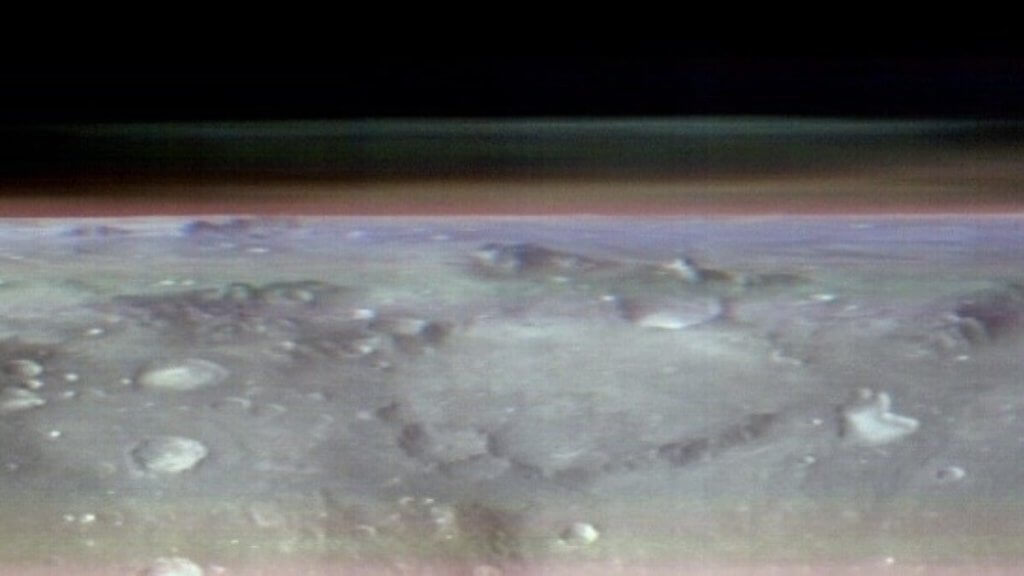Imagine being in the International Space Station and looking at the world below — except instead of gazing down at Earth, it’s Mars.
NASA has just used its eldest Martian spacecraft to take vast panoramic images of the Red Planet from about 250 miles above the surface. That’s the same altitude as the space laboratory flying continuously over Earth.
Astronauts have spoken so much about how this rare perspective of our own planet has rapt them that they’ve given it a name: the overview effect. One could only assume the overview of Mars would be as emotional and transcendent, adding new depth to the concept of being a citizen of the universe.
“If you were an astronaut, the first thing that would catch your eye are all of these beautiful craters, which of course look much different than what you would see on Earth,” said Laura Kerber, deputy project scientist for the Mars Odyssey orbiter, in a NASA video.
The new look at Mars’ horizon, taken by the Odyssey orbiter, wasn’t just for pretty pictures, but to give scientists an expansive view of Mars’ atmosphere. It captured clouds and dust, along with one of its two tiny moons, Phobos.
The second thing astronauts in a hypothetical Mars-orbiting space station might notice are the structures of the clouds, which can differ from the lofty water vapor clouds humans are accustomed to seeing on Earth. In Mars’ skies, there are carbon dioxide ice clouds, water-ice clouds, and dust clouds — all distinguishable with Odyssey’s infrared camera, THEMIS.
To execute this project, engineers at NASA’s Jet Propulsion Laboratory in Southern California and Lockheed Martin spent three months planning. The result was 10 images stitched end-to-end, offering scientists new insights into the planet over 230 million miles away. (With both planets constantly moving, the distance is always changing. Right now, Earth and Mars are almost at their maximum distance apart.)
The new panoramic is so wide, the complete image had to be cropped at the top of this story. To get the full effect, see below:

Credit: NASA / JPL-Caltech / ASU
Want more science and tech news delivered straight to your inbox? Sign up for Mashable’s Light Speed newsletter today.
The difficulty in capturing the panorama lay in changing the orbiter’s angle. Usually Odyssey’s camera faces straight down to map ice, rock, sand, and dust on the planet’s surface. In the past, the mission team experimented with rolling Odyssey out to catch pictures of the potato-shaped moon, Phobos.
“This time we had to do something a little more extreme,” Kerber said.
In May, the team rotated the robotic spacecraft all the way to the horizon and kept it that way for an entire orbit.
From this vantage point, scientists can better observe the details of the atmosphere, like whether there’s one layer of water-ice clouds and dust, or several stacked on top of each other.
“I think of it as viewing a cross-section, a slice through the atmosphere,” said Jeffrey Plaut, Odyssey’s project scientist, in a statement. “There’s a lot of detail you can’t see from above, which is how THEMIS normally makes these measurements.”
Credit: NASA / JPL-Caltech
While capturing new images of Phobos, the team had to ensure the sun would hit Odyssey’s solar panels to maintain its power while not exposing some of the sensitive instruments to too much heat. That required orienting the spacecraft so that its antenna pointed away from Earth. The tradeoff was not being able to communicate with Odyssey for several hours during the operation.
This was the seventh time the orbiter, which has been flying around Mars since 2001, pointed its camera at Phobos over its lifetime to measure temperature variations across the Martian moon’s surface.
Scientists say these studies could help solve the mystery of whether the moon, only 16 miles wide, used to be an asteroid or is a blown-off chunk of Mars from an ancient cosmic collision.
Topics
NASA

